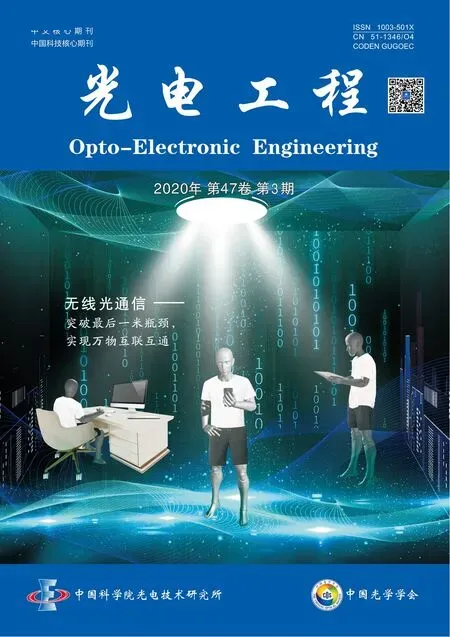预编码室内MIMO可见光通信系统空间相关性分析
张 颖,高 悦,柯熙政
预编码室内MIMO可见光通信系统空间相关性分析
张 颖1,2,高 悦1*,柯熙政1,2
1西安理工大学自动化与信息工程学院,陕西 西安 710048;2陕西省智能协同网络军民共建重点实验室,陕西 西安 710048
为了解决多用户MIMO(MU-MIMO)室内可见光通信中存在用户间干扰问题及对角化(BD)算法所产生的子信道强弱的问题,利用子流选择BD算法,对室内MU-MIMO 可见光通信系统的误码率进行优化。建立了MU-MIMO室内可见光通信的信道模型,利用控制变量法并采用不同LED与PD距离的参数,对比了在4´4 MIMO与8´8 MIMO两种不同的室内系统布局方式下的信道空间相关性,分析对比子流选择BD算法及BD算法的系统容量及误码率性能。结果表明,随着空间相关的不断增强,误码率性能下降,子流选择BD算法相对于BD算法可以带来4 dB以上的增益。
可见光通信;子流选择;信道相关性;块对角化
1 引 言
可见光通信(Visible light communication,VLC)已影响着人们的生活,为达到实际照明标准以及避免通信中断,将多输入多输出(multi-input multi-output,MIMO)技术应用于室内VLC系统中形成可见光MIMO技术[1],不仅扩大信号的到达范围,还提高数据传输速率[2]。
针对MIMO VLC系统的研究很多,主要集中在优化室内的光源布局、信号调制方式、分集接收等方面。赵黎等[3]设计了一种优化的环形光源布局;Ishikawa等[4]使用空间调制技术对功率不平衡MIMO系统的容量进行最大化;薛家豪等[5]利用分集接收技术设计了光电二极管的布局及数据选择接收装置,保证通信质量。Huang等[6]设计了一种改进型规整晶格解码技术的MIMO VLC系统的收发器;Narmanlioglu等[7]采用非顺序光线跟踪对各种实际布线和布线拓扑进行MIMO VLC信道建模。然而,接收端通常会接收到来自于其他用户数据的干扰,从而造成系统性能下降。线性预编码算法可以有效地降低来自于其他用户的数据干扰及接收端的复杂度[8],其中块对角化(block diagonalization,BD)算法是一种典型的线性预编码技术,但BD算法的研究主要用于降低用户间的干扰及提高系统性能方面[9],在室内MIMO VLC系统的空间相关性研究较少。由于室内MIMO VLC系统中LED光源与光电检测器(photoelectric detector,PD)的不同位置组合会出现不同的子信道,同时影响MIMO信道的空间相关性及系统性能[10],因此研究预编码技术的室内MIMO VLC系统信道的空间相关性具有重要意义。
论文将无线通信中的子流选择BD技术[11]应用到室内多用户MIMO(multipleuser MIMO,MU-MIMO)VLC系统中,讨论了室内MIMO VLC系统的空间相关性,同时解决了BD算法中因等效信道矩阵经奇异值分解(singular value decomposition,SVD)后子信道强弱不均衡的问题,实现降低多用户干扰的目的,提高系统传输速率。仿真分析验证了该方法的可行性。
2 系统模型


式中:hij为第i个LED阵列和用户j的PD之间的信道直流增益,即:


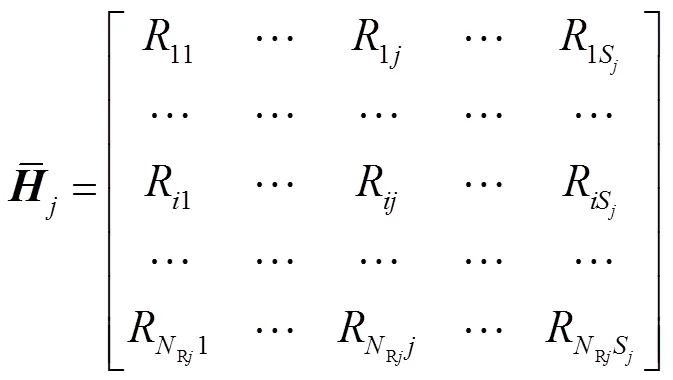
式中:R为第个LED阵列与用户的检测器间信道的等效直流增益。
经第个用户的探测器的光电转换和滤除直流分量后,最后输出为

第个用户输出端的信噪比(signal to noise ratio,SNR)及系统误码率(bit error rate,BER)分别定义为
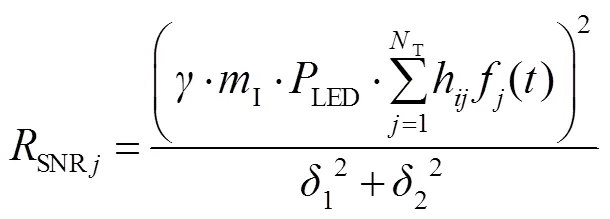

式中函数定义为

3 预编码和解码方案
3.1 子流选择BD算法的预编码方案




用户的预编码矩阵为

在接收端,用户接收到的信号为

由式(4)和子流选择BD预编码矩阵可得系统和容量为
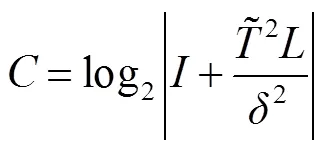
3.2 子流选择BD算法的解码方案

4 系统仿真结果


图2 室内MIMO VLC系统4´4的空间分布。(a) LED的空间分布;(b) PD的空间分布

图3 室内MIMO VLC系统8´8的空间分布。(a) 8个LED的空间分布;(b) 8个PD的空间分布

表1 仿真参数
取LED=2且PD=2时,分别求得4´4及8´8信道增益矩阵的条件数(1)=8.4274,(2)=1.1755E+017,8´8的信道相关性强于4´4。取LED=1.5且PD=1.5时,两种信道矩阵的条件数分别为(3)=13.8906,(4)=3.2784E+017。取LED=1.0且PD=1.0时,两种信道矩阵的条件数分别为(5)=33.2971,(6)=5.6754E+017。因此,LED、PD间隔的缩小,信道的相关性增强。
通过在信道空间相关性的四种取值下,信道容量与SNR的仿真如图4所示。可见LED、PD取值越小,随着信道相关性的增强,信道容量上升的斜率变大。在4´4 MIMO的信道下,BD算法的信道容量受信道相关性影响小于子流选择BD算法,但在8´8 MIMO的信道下,相关性对两种算法信道容量的影响区别不大。
图5为不同信道相关性下,系统的SNR与BER关系曲线。可以得到,子流选择BD算法的BER性能较BD来说有4 dB以上增益,这是子流选择BD算法在奇异值大的子流信道用于数据通信而获得的。同时,随着信道相关性的变强,系统的BER提升。在图5(a),8´8 信道的子流选择BD算法室内VLC系统中BER取10-3时所需SNR约为15.5 dB,而图5(b)约为19.5 dB,图5(c)则需要更大的信噪比。因此,可以看出,在8´8的MIMO信道中,不同相关性的BD算法与子流选择BD算法的信道容量曲线趋势大致相同;但在相同的系统BER性能下,子流选择BD算法所需SNR的值比BD算法小,且空间相关性与系统的BER性能呈反比关系。
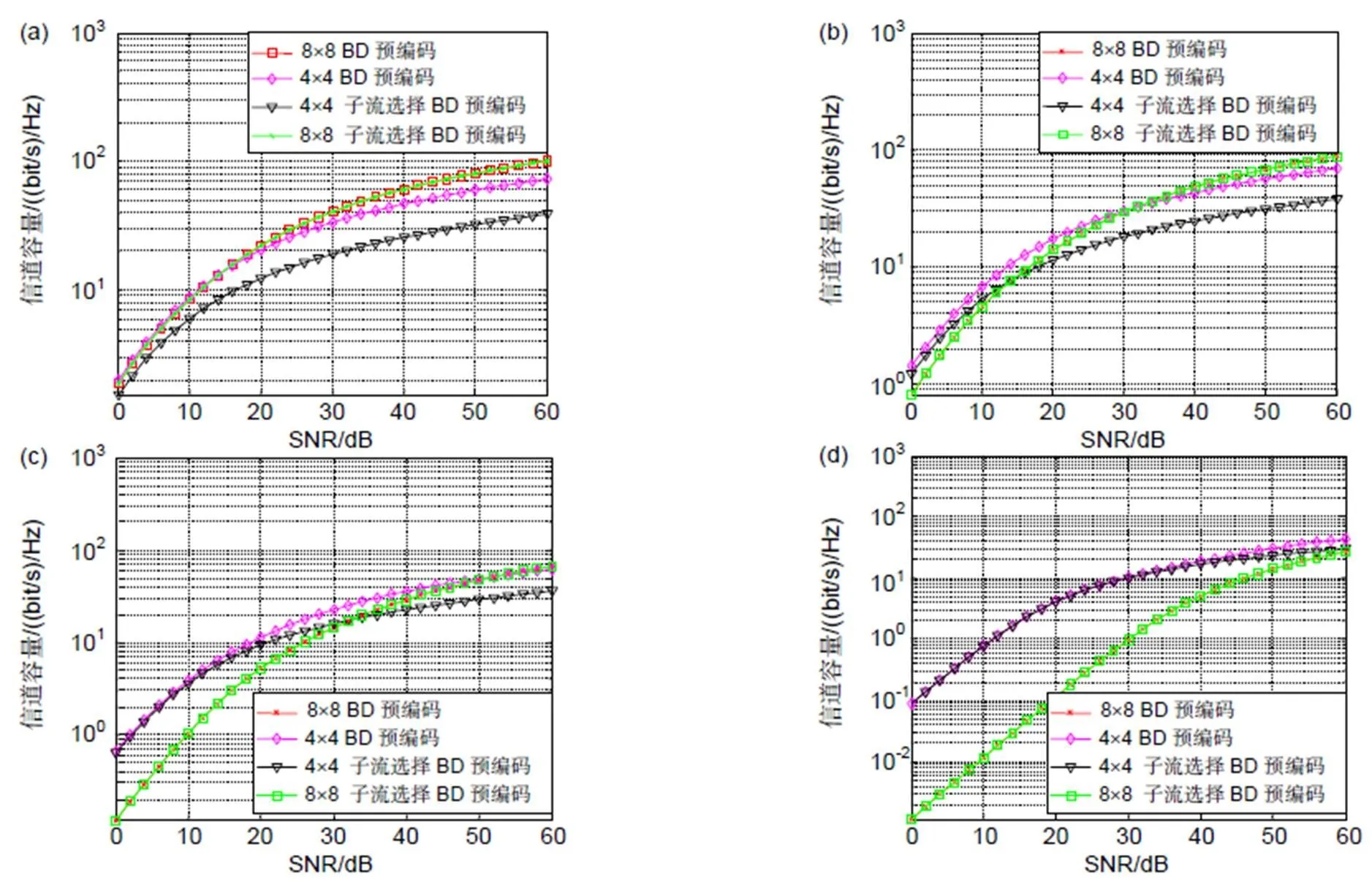
图4 四种空间相关性下SNR与信道容量的曲线。
(a)LED=2,PD=2;(b)LED=1.5,PD=1.5;(c)LED=1.0,PD=1.0;(d)LED=0.5,PD=0.5
Fig. 4 Curve between SNR and channel capacity under four spatial correlation.
(a)LED=2,PD=2; (b)LED=1.5,PD=1.5; (c)LED=1.0,PD=1.0; (d)LED=0.5,PD=0.5
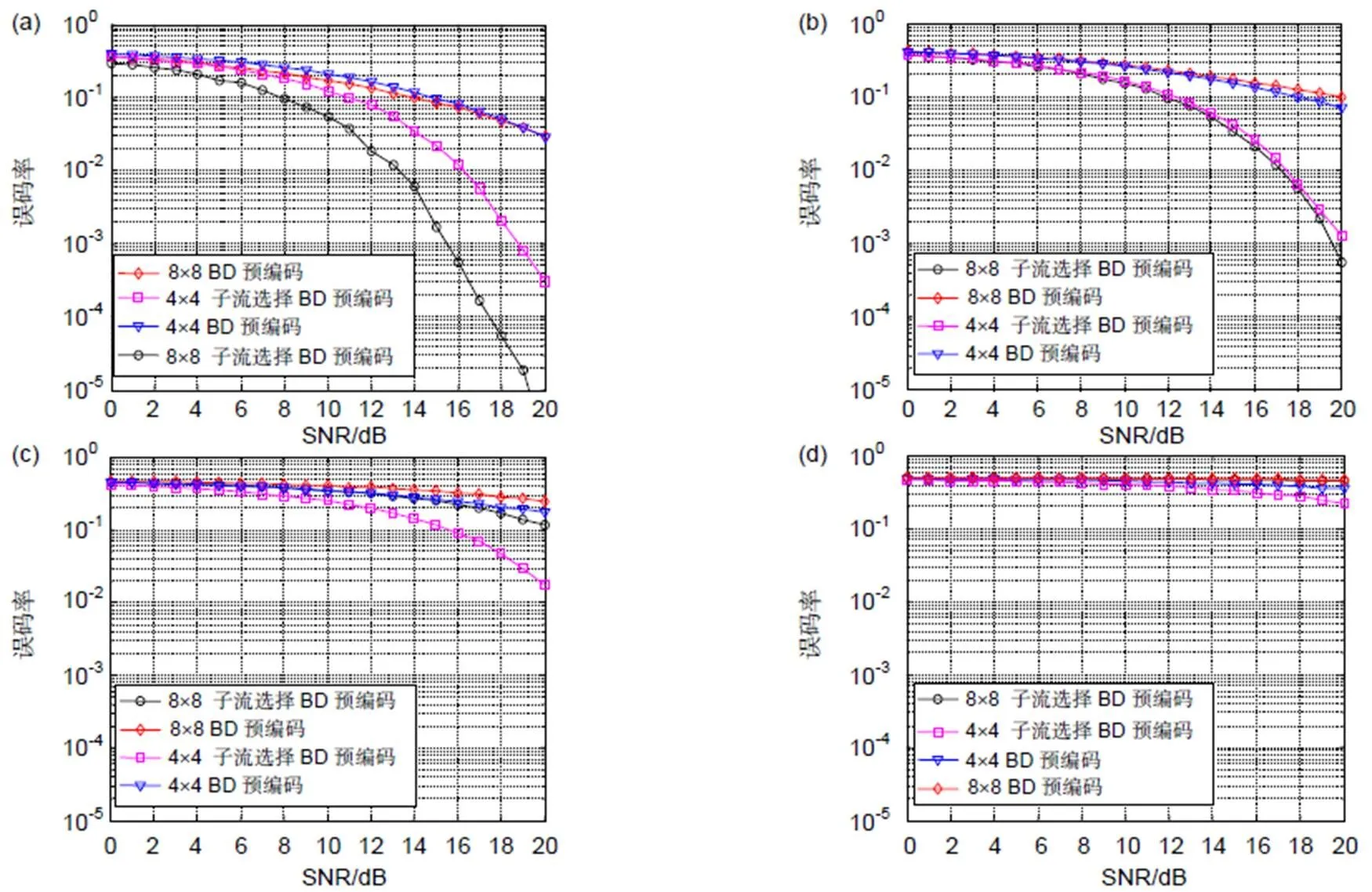
图5 不同信道相关性下SNR与BER的曲线。
(a)LED=2,PD=2;(b)LED=1.5,PD=1.5;(c)LED=1.0,PD=1.0;(d)LED=0.5,PD=0.5
Fig. 5 Curve between SNR and BER under different channel correlation.
(a)LED=2,PD=2; (b)LED=1.5,PD=1.5; (c)LED=1.0,PD=1.0; (d)LED=0.5,PD=0.5
5 结 论
本文利用子流选择BD算法,讨论了在MU-MIMO室内VLC系统中不同的空间相关性下对系统信道容量及BER的影响。结果表明:随着空间相关性的不断增大,信道容量上升的斜率随之变大,同时在8´8的MIMO布局中,在不同信道空间相关性中,BD算法和子流选择BD算法的信道容量区别不大;子流选择BD算法的BER相对于BD算法可以带来4 dB以上的增益。
[1] Tran T A, O'Brien D C. Performance metrics for Multi-Input Multi-Output (MIMO) visible light communications[C]//, 2012.
[2] Wang Y G, Zhang M L, Wang Y Q,. Experimental demonstration of visible light communication based on sub-carrier multiplexing of multiple-input-single-output OFDM[C]//, 2012: 745–746.
[3] Zhao L, Zhu T, Liu Z G,. An annular light source layout model for both lighting and communication reliability[J]., 2018, 45(7): 170503.
赵黎, 朱彤, 刘智港, 等. 一种兼顾照明与通信的环形光源布局模型[J]. 光电工程, 2018, 45(7): 170503.
[4] Ishikawa N, Sugiura S. Maximizing constrained capacity of power-imbalanced optical wireless MIMO communications using spatial modulation[J]., 2015, 33(2): 519–527.
[5] Xue J H, Li Q, Xu S N,. Diversity reception system for indoor LED visible light communication[J]., 2016, 36(9): 15–18, 22.
薛家豪, 李琪, 徐胜男, 等. 室内LED可见光通信的分集接收系统[J]. 物理实验, 2016, 36(9): 15–18, 22.
[6] Huang N, Wang X, Chen M. Transceiver Design for MIMO VLC Systems With Integer-Forcing Receivers[J]., 2018, 36(1): 66–77.
[7] Narmanlioglu O, Kizilirmak R C, Miramirkhani F,. Effect of Wiring and Cabling Topologies on the Performance of Distributed MIMO OFDM VLC Systems[J]., 2019: 52743–52754.
[8] Chen J X, Wang Q, Wang Z C. Leakage-based precoding for MU-MIMO VLC systems under optical power constraint[J]., 2017, 382: 348–353.
[9] Hong Y, Chen J, Wang Z X. Multi-user MIMO indoor visible light communication system based on BD precoding algorithm[J]., 2013, 42(11): 1277–1282.
洪阳, 陈健, 王子雄. 基于BD预编码的多用户MIMO室内可见光通信系统[J]. 光子学报, 2013, 42(11): 1277–1282.
[10] Liu Q F, Xiao S F, Huang K Z,. A SVD-based optical MIMO precoding scheme in indoor visible light communication[J]., 2014, 3(6): 421–426.
[11] Zhu K, Wang L, Hu H Y. Improved BD precoding algorithms for multi-user MIMO systems[J]., 2010, 11(1): 7–10.
祝锴, 王丽, 胡捍英. 基于BD的改进多用户MIMO预编码算法[J]. 信息工程大学学报, 2010, 11(1): 7–10.
[12] Ding J P, Huang Z T, Ji Y F. Evolutionary algorithm based power coverage optimization for visible light communications[J]., 2012, 16(4): 439–441.
Analysis of spatial correlation of precoding indoor MIMO visible light communication system
Zhang Ying1,2, Gao Yue1*, Ke Xizheng1,2
1School of Automation and Information Engineering, Xi¢an University of Technology, Xi¢an, Shaanxi 710048, China;2Shaanxi Civil-Military Integration Key Laboratory of Intelligence Collaborative Networks, Xi¢an, Shannxi 710048, China

Substream selected BD algorithm MU-MIMO indoor VLC system model
Overview:Visible light communication is a kind of wireless communication, which can solve the problem of serious electromagnetic radiation or limited spectrum resources in hospitals, mines, military, etc. It’s a new communication technology with green, high efficiency and energy saving. In the actual application scenario, there are multiple users and multiple sets of LEDs in the room, which can effectively reduce the communication link interruption caused by indoor displays and personnel walking. There are many researches on indoor MIMO visible light communication, most of which are mainly to solve the problem of indoor layout, diversity reception and so on. However, the receiver can receive interference from others. Precoding technology is mainly used to reduce the inter-user interference now, but the spatial correlation research of precoding for visible light communication is relatively rare. In this paper, two indoor MIMO visible light communication system models are established, namely 4´4 and 8´8. The substream selected BD algorithm is applied to the indoor MIMO visible light communication system. By optimizing the singular value of the singular value decomposition caused by the BD algorithm in the equivalent channel matrix, the purpose of reducing inter-user interference is realized. At the same time, under different indoor system models and the distribution of LED and PD, the channel capacity and bit error rate performance of BD algorithm and substream selected BD algorithm are studied. The indoor MIMO visible light communication system with substream selected BD algorithm in the above figure mainly includes three parts: the transmitter, the receiver and channel. The transmitter mainly performs serial-to-parallel conversion of data, controls the parallel data modulation by on-off keying modulation and processes substream selected BD algorithm, and to add the DC offset and use the high frequency flickering characteristic of the LED to perform data transmission; at the receiver, the received signal is decoded and demodulated by the optical detector to restore the original data and complete the information transmission. The simulation results show that in terms of channel capacity, the spatial correlation of the channel is stronger and the channel capacity is increased. Meanwhile, under the indoor channel of 4´4, the channel capacity of the BD algorithm is higher than the substream selected BD algorithm under different spatial correlations, but under the indoor 8´8 channel, BD algorithm and substream selected BD algorithm have little difference in capacity under different spatial correlation; in terms of the bit error rate of the system, the bit error rate of the substream selected BD algorithm can bring a gain of more than 4 dB compared with the BD algorithm, the spatial correlation is continuously enhanced, and the system error rate performance is degraded.
Citation: Zhang Y, Gao Y, Ke X ZAnalysis of spatial correlation of precoding indoor MIMO visible light communication system[J]., 2020, 47(3): 190666
Analysis of spatial correlation of precoding indoor MIMO visible light communication system
Zhang Ying1,2, Gao Yue1*, Ke Xizheng1,2
1School of Automation and Information Engineering, Xi¢an University of Technology, Xi¢an, Shaanxi 710048, China;2Shaanxi Civil-Military Integration Key Laboratory of Intelligence Collaborative Networks, Xi¢an, Shannxi 710048, China
In order to solve the problem of multi-user interference and the subchannel strength generated by the block diagonalization (BD) algorithm in multi-user MIMO (MU-MIMO) indoor visible light communication, the bit error rate of the indoor MU-MIMO visible light communication system is optimized by using the substream selected BD algorithm. This paper establishes the channel model for MU-MIMO indoor visible light communication and compares the channel spatial correlation between the 4´4 MIMO and 8´8 MIMO in different indoor system layout modes by using the control variable method and taking different parameters of LED and PD distance, the system capacity and bit error rate performance of substream selected BD algorithm and BD algorithm are compared and analyzed. The results show that with the continuous enhancement of spatial correlation, the bit error rate performance decreases, and the substream selected BD algorithm can bring a gain of more than 4 dB compared with BD algorithm.
visible light communication; substream selected; channel correlation; block diagonalization
TN929.1
A
10.12086/oee.2020.190666
: Zhang Y, Gao Y, Ke X Z. Analysis of spatial correlation of precoding indoor MIMO visible light communication system[J]., 2020,47(3): 190666
2019-11-02;
2019-11-29
陕西省重点产业创新链工程(2017ZDCXL-GY-06-01);陕西省教育厅自然科学基金(17JK0569);陕西省教育厅科研计划项目(18JK0341);西安市科技创新引导项目(201805030YD8CG14(12))
张颖(1982-),女,博士,讲师,主要从事可见光通信及Ad Hoc网络拓扑的研究。E-mail:zhangying@xaut.edu.cn
高悦(1993-),女,硕士研究生,主要从事可见光通信多用户预编码技术的研究。E-mail:yuegao56510@163.com
张颖,高悦,柯熙政. 预编码室内MIMO可见光通信系统空间相关性分析[J]. 光电工程,2020,47(3): 190666
Supported by Key Industry Innovation Chain Project of Shaanxi Province (2017ZDCXL-GY-06-01), Natural Science Foundation of Shaanxi Provincial Department of Education (17JK0569), Scientific Research Project of Education Department of Shaanxi Province (18JK0341), and Xi'an Science and Technology Innovation Guidance Project (201805030YD8CG14(12))
* E-mail: yuegao56510@163.com

